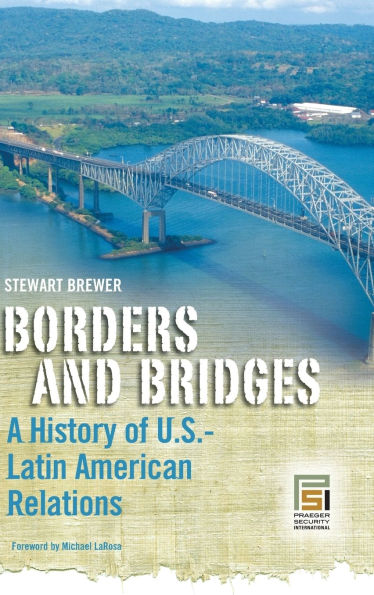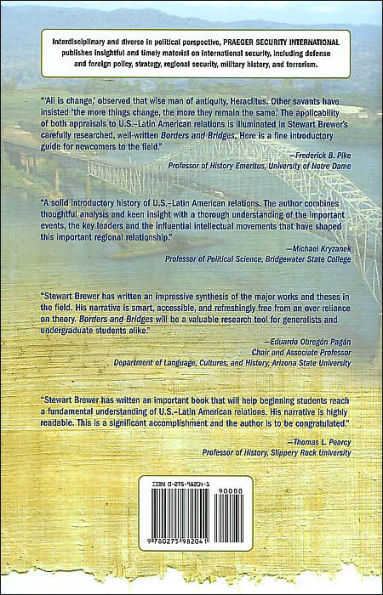Borders and Bridges: A History of U.S.-Latin American Relations
The symbiotic relationship between the United States and Latin America has been filled with bitterness and anguish, on the one hand, and hope and cooperation, on the other. Each provides something the other lacks, and thus the relationship has the potential to work to the advantage of both. Brewer provides an introduction to the most important events in the diplomatic, military, social, and economic history of the relationship between the United States and countries of Latin America.
The symbiotic relationship between the United States and Latin America has been filled with bitterness and anguish, on the one hand, and hope and cooperation, on the other. Each provides something the other lacks, and thus the relationship has the potential to work to the advantage of both. Brewer provides an introduction to the the most important events in the diplomatic, military, social, and economic history of the relationship between the United States and countries of Latin America.
Soon after the American Revolutionary War, the new nation needed to build a solid relationship with Latin American countries in order to survive. The apex of hemispheric relations was not reached until World War II, when the area witnessed an unprecedented level of cooperation and mutual collaboration. This era ended with the onset of the Cold War, when the competition between capitalism and communism was fought by proxy throughout the developing world, adversely affecting the ability of Latin American nations to develop independent identities or thriving economies. Brewer argues that the events of 9/11 changed this relationship very little. Indeed, many of the issues that have long plagued U.S.-Latin American relations are returning as the United States focuses on the War on Terror in the Middle East and neglects its southern neighbors.
1101460841
The symbiotic relationship between the United States and Latin America has been filled with bitterness and anguish, on the one hand, and hope and cooperation, on the other. Each provides something the other lacks, and thus the relationship has the potential to work to the advantage of both. Brewer provides an introduction to the the most important events in the diplomatic, military, social, and economic history of the relationship between the United States and countries of Latin America.
Soon after the American Revolutionary War, the new nation needed to build a solid relationship with Latin American countries in order to survive. The apex of hemispheric relations was not reached until World War II, when the area witnessed an unprecedented level of cooperation and mutual collaboration. This era ended with the onset of the Cold War, when the competition between capitalism and communism was fought by proxy throughout the developing world, adversely affecting the ability of Latin American nations to develop independent identities or thriving economies. Brewer argues that the events of 9/11 changed this relationship very little. Indeed, many of the issues that have long plagued U.S.-Latin American relations are returning as the United States focuses on the War on Terror in the Middle East and neglects its southern neighbors.
Borders and Bridges: A History of U.S.-Latin American Relations
The symbiotic relationship between the United States and Latin America has been filled with bitterness and anguish, on the one hand, and hope and cooperation, on the other. Each provides something the other lacks, and thus the relationship has the potential to work to the advantage of both. Brewer provides an introduction to the most important events in the diplomatic, military, social, and economic history of the relationship between the United States and countries of Latin America.
The symbiotic relationship between the United States and Latin America has been filled with bitterness and anguish, on the one hand, and hope and cooperation, on the other. Each provides something the other lacks, and thus the relationship has the potential to work to the advantage of both. Brewer provides an introduction to the the most important events in the diplomatic, military, social, and economic history of the relationship between the United States and countries of Latin America.
Soon after the American Revolutionary War, the new nation needed to build a solid relationship with Latin American countries in order to survive. The apex of hemispheric relations was not reached until World War II, when the area witnessed an unprecedented level of cooperation and mutual collaboration. This era ended with the onset of the Cold War, when the competition between capitalism and communism was fought by proxy throughout the developing world, adversely affecting the ability of Latin American nations to develop independent identities or thriving economies. Brewer argues that the events of 9/11 changed this relationship very little. Indeed, many of the issues that have long plagued U.S.-Latin American relations are returning as the United States focuses on the War on Terror in the Middle East and neglects its southern neighbors.
The symbiotic relationship between the United States and Latin America has been filled with bitterness and anguish, on the one hand, and hope and cooperation, on the other. Each provides something the other lacks, and thus the relationship has the potential to work to the advantage of both. Brewer provides an introduction to the the most important events in the diplomatic, military, social, and economic history of the relationship between the United States and countries of Latin America.
Soon after the American Revolutionary War, the new nation needed to build a solid relationship with Latin American countries in order to survive. The apex of hemispheric relations was not reached until World War II, when the area witnessed an unprecedented level of cooperation and mutual collaboration. This era ended with the onset of the Cold War, when the competition between capitalism and communism was fought by proxy throughout the developing world, adversely affecting the ability of Latin American nations to develop independent identities or thriving economies. Brewer argues that the events of 9/11 changed this relationship very little. Indeed, many of the issues that have long plagued U.S.-Latin American relations are returning as the United States focuses on the War on Terror in the Middle East and neglects its southern neighbors.
61.0
In Stock
5
1

Borders and Bridges: A History of U.S.-Latin American Relations
216
Borders and Bridges: A History of U.S.-Latin American Relations
216Hardcover(New Edition)
$61.00
61.0
In Stock

Product Details
| ISBN-13: | 9780275982041 |
|---|---|
| Publisher: | Bloomsbury Academic |
| Publication date: | 05/30/2006 |
| Series: | Praeger Security International |
| Edition description: | New Edition |
| Pages: | 216 |
| Product dimensions: | 6.14(w) x 9.21(h) x 0.56(d) |
About the Author
What People are Saying About This
From the B&N Reads Blog



